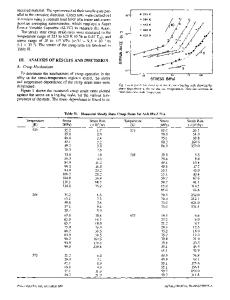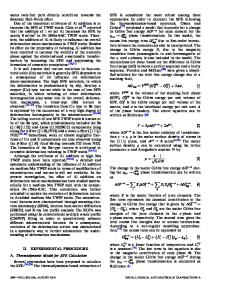Deformation mechanisms of Al films on oxidized Si wafers
- PDF / 1,097,575 Bytes
- 9 Pages / 576 x 792 pts Page_size
- 36 Downloads / 349 Views
C. F. Alofs and J. R. Liefting FOM Institute AMOLF, Amsterdam, The Netherlands (Received 17 March 1993; accepted 24 January 1994)
The mechanism for plastic deformation of 0.5 /am thick, 0.5 ^ m grain-size evaporated Al films on oxidized Si wafers has been studied using wafer curvature measurements over a temperature range from room temperature to 500 °C. Extensive evidence for both morphology changes and plastic deformation was obtained. Transmission electron microscopy confirmed the occurrence of grain growth, and stress changes attributed to recrystallization were observed. Deformation under tension could be explained by dislocation glide according to the kinetics observed in bulk Al at the same temperatures, stresses, and grain sizes. The kinetics of deformation under compression were investigated at 400 °C and were completely different from those under tension. This is either due to a difference in the deformation mechanism or to the occurrence of work softening.
I. INTRODUCTION Thin Al films on oxidized Si substrates are known to deform during temperature cycling due to the difference in thermal expansion coefficients between the film and the substrate. This deformation has been studied extensively,1"9 largely motivated by a desire to understand possible differences between deformation in bulk materials and thin films, as well as to understand the nature of stress-induced reliability problems in Al microelectronic interconnects, such as hillock and void formation. The process of deformation in bulk Al has been well characterized.10 It is known that at low stress and high temperatures, deformation is dominated by diffusional flow of point defects. As the stress is increased and the temperature decreased, the dominant deformation mechanism first changes to dislocation climb and then to dislocation glide. In each of these regimes of deformation, the other mechanisms are also active, but their contribution is small. It is known from these studies that the sample morphology, in particular the grain size, texture, impurities, sample dimensions, and dislocation density, can have a large effect on deformation.11"13 In the study of deformation on thin Al films on rigid substrates, it has generally been assumed that the dominant deformation mechanism is dislocation glide,3"6 as in fact would be expected from the behavior of bulk Al at the temperatures and stresses accessed in the thin film studies. This assumption has not been rigorously tested by studying isothermal stress relief kinetics, although studies of grain size and film thickness effects714 support the idea that dislocation glide is in fact the dominant mechanism. J. Mater. Res., Vol. 9, No. 5, May 1994
http://journals.cambridge.org
Downloaded: 13 Mar 2015
In contrast to the studies of deformation mechanisms, discussions of void and hillock formation in Al lines and films on Si substrates have pointed to grain boundary sliding or diffusional flow of point defects as the important mechanism.15"17 The purpose of the present investigation is to determine whi
Data Loading...











